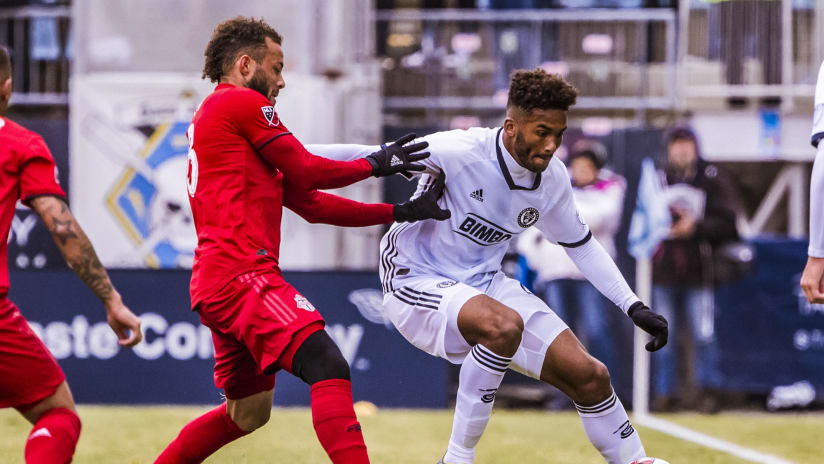When Philadelphia Union were pushing for a comeback on Saturday against Toronto FC, head coach Jim Curtin added striker Sergio Santos to his eleven and made the somewhat surprising decision to pull defender Ray Gaddis. Including last season's playoff match against NYCFC, this marked the second straight time Curtin had adapted his shape to the scoreline and showed a Union side willing to send attackers forward in pursuit of a result.
Describing the Union's shape during the final portion of last Saturday's match as a back three is too simplistic, though. At times, a back three actually means a back five, with the two wide defenders returning with discipline to create a long band of teammates with fairly equal spacing between them. This system, familiar to anybody that watched Antonio Conte's Chelsea sides, differs from the one Curtin used when down two against Toronto. The Union's system prioritized attacking, which meant that the three remaining defenders often had to cover endline to endline in order to allow David Accam and Fafa Picault to bomb forward.
During this period, second year defender Auston Trusty moved to the center of the back three. PhiladelphiaUnion.com spoke to him about that role and how he adjusted to it in-game. "It's a lot of communication," he began. "When you play a four-back the whole game, you are in the mindset that you have a guy next to you and different spacing.”
"But then when you switch into a three-back, a lot of people are playing different roles. Kai on the left side, he's playing left center back and left back. I'm playing both sides of the center back, and Jack's playing both right back and right center back. So you have to keep in mind that you have fewer numbers in the back, so you have more responsibility and a bigger role."
That change in spacing means some of the cues that a player has relied on throughout the match as a guide to moving and responding to play can quite suddenly mean something different. And for Trusty, defensive solidity begins with good structure. "People staying, people sliding, knowing which man to mark," he continued. "When that changes, it calls for a lot of communication because it's big in the middle of the game and you have to be organized."
To maintain that structure as the team's shape morphs requires work on the training ground. The Union have often played out of a 4-2-3-1 shape in the past, but even last season there were times when their right-sidedness meant they could push one fullback high and hold the other deeper, or drop midfielder Haris Medunjanin between the center backs to recreate the spacing and numerical advantages a back three can offer. Trusty said the team has put in the time understanding a back three system, so his reads in the final half hour of the match were not unfamiliar.
"We do it all the time in training," he explained. "Different situations, different games require you to be prepared for it. It's just about implementing it. Still the same passes, still the same looks, still same mindset toward how you play the game."
It is unlikely the Union will trot out a three-back set to start this Sunday's match at Sporting Kansas City. But if they do, Trusty and his fellow center backs will be ready to execute. That confidence in himself and in the coaching staff to prepare him for multiple scenarios is what has the young defender excited to help his team take a step forward in 2019.
The Union face off against Sporting KC at 3 p.m. ET on PHL17.













